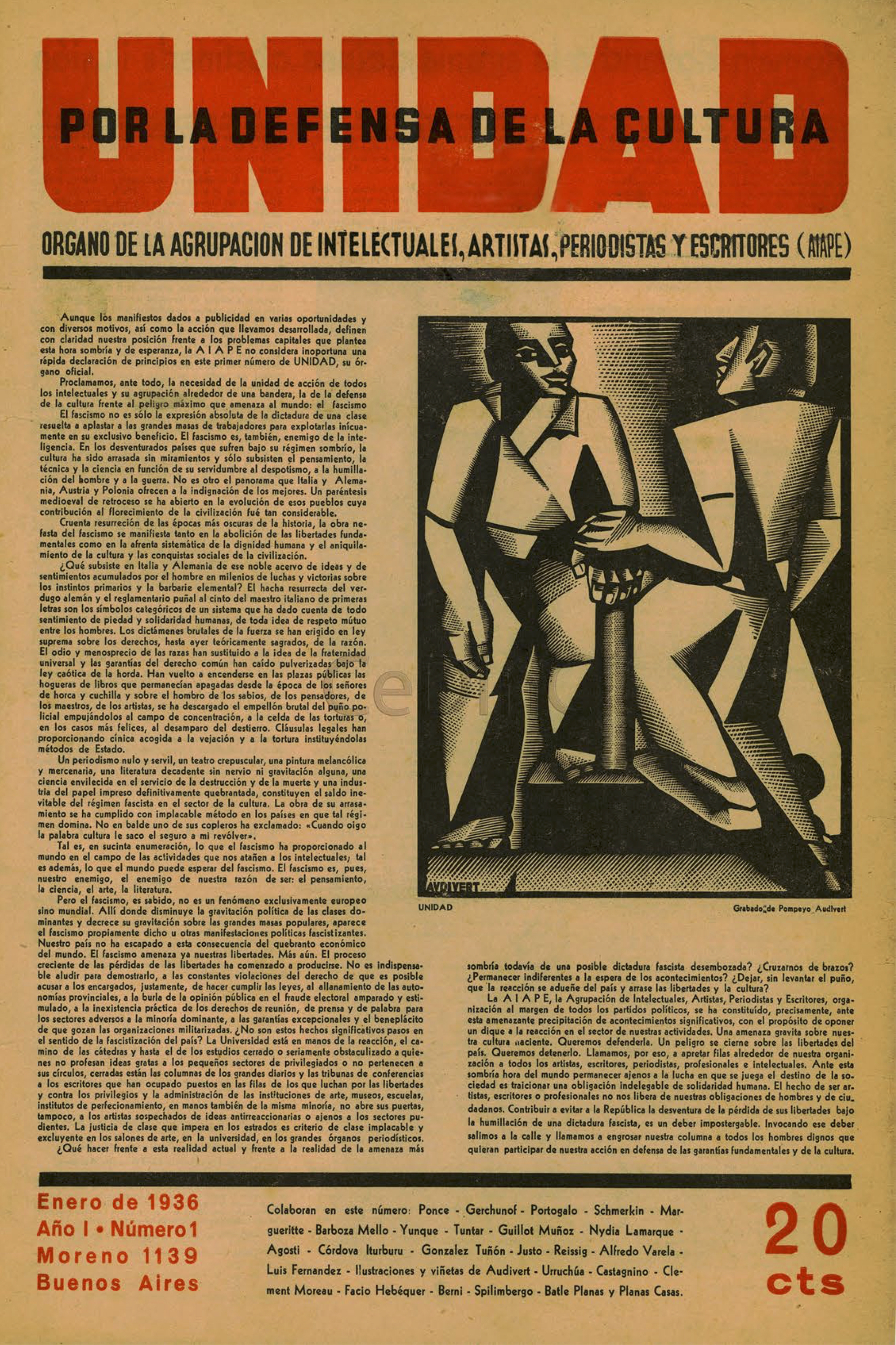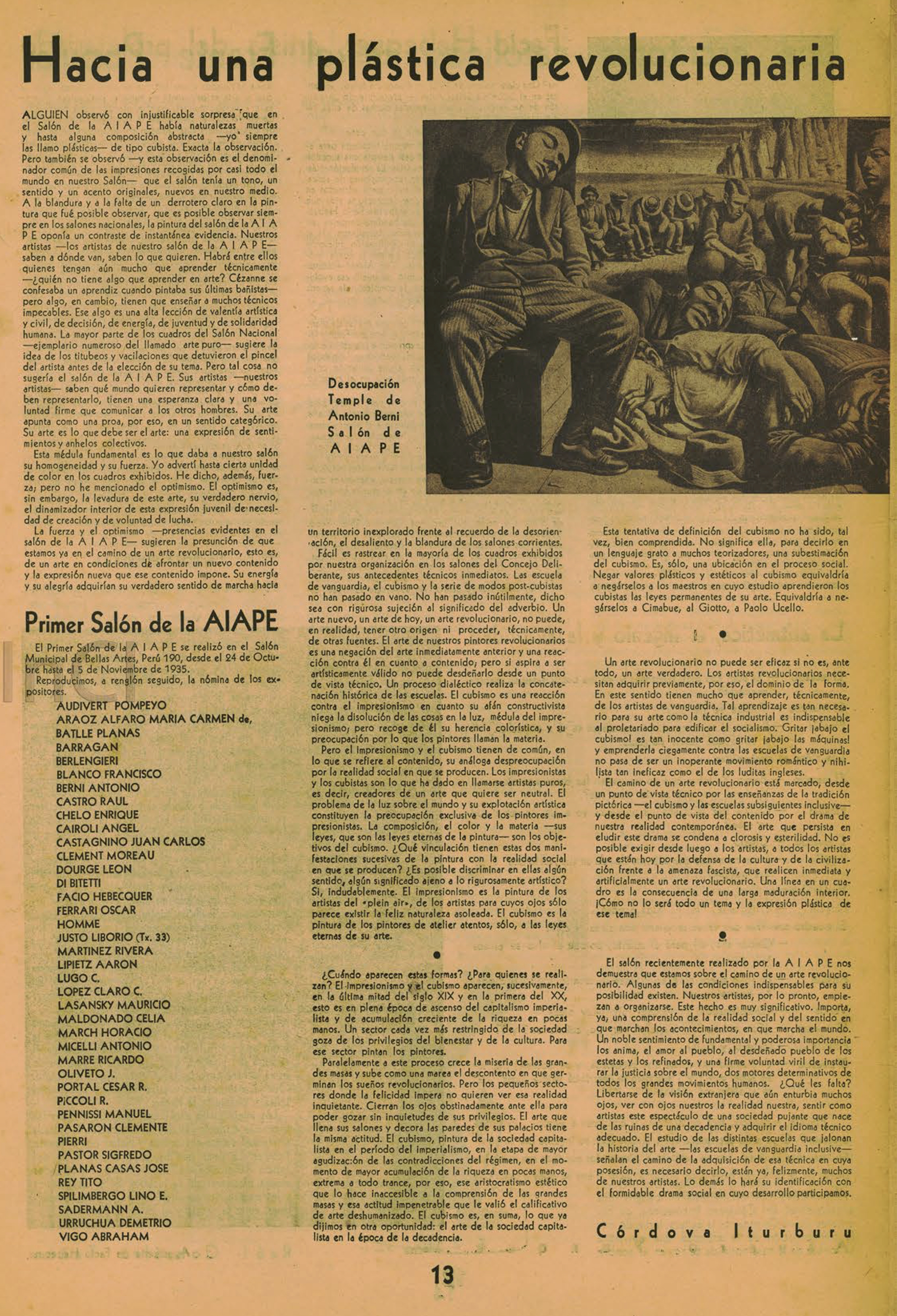Archive
Agrupación de Intelectuales, Artistas, Periodistas y Escritores (AIAPE)
- Agrupación de Intelectuales, Artistas, Periodistas y Escritores (AIAPE)
Association of Intellectuals, Artists, Journalists and Writers
- Association
The Agrupación de Intelectuales, Artistas, Periodistas y Escritores – AIAPE (Association of Intellectuals, Artists, Journalists and Writers) was a main association that helped migrants integrate into Buenos Aires’ cultural life.
Word Count: 30
Federación de Sociedades Gallegas, Calle Belgrano 1732, Buenos Aires (meeting place); Salón Municipal de Bellas Artes, Calle Perú 190, Buenos Aires (exhibition venue).

Pompeyo Audivert, Unidad, cover of Unidad por la Defensa de la Cultura, no. 1, January 1936. CeDInCI, Buenos Aires. 
Córdova Iturburu, Cayetano. "Primer Salón de la AIAPE." Unidad por la Defensa de la Cultura, no. 1, January 1936, p. 13. CeDInCI, Buenos Aires. Bisso, Andrés and Adrián Celentano. “La lucha antifascista de la Asociación de Intelectuales, Artistas, Periodistas y Escritores (AIAPE) (1935–1943).” El pensamiento alternativo en la Argentina del siglo XX, edited by Arturo A. Roig and Hugo E. Biagini, Biblos, 2006, pp. 235–265.
Pasolini, Ricardo. “Scribere in eos qui possunt proscribere: consideraciones sobre intelectuales y prensa antifascista en Buenos Aires y París durante el período de entreguerras.” Prismas. Revista de Historia Intelectual, no. 12, 2008, pp. 87–108, https://ridaa.unq.edu.ar/handle/20.500.11807/1948. Accessed 14 April 2021.
Word Count: 82
Centro de Documentación e Investigación de la Cultura de Izquierdas (CeDInCI), Buenos Aires, http://cedinci.org/.
Córdova Iturburu, Cayetano. "Primer Salón de la AIAPE." Unidad por la Defensa de la Cultura, year 1, no. 1, January 1936, p. 13. América Lee, CeDInCI, http://americalee.cedinci.org/wp-content/uploads/2019/08/unidadAIAPE_a%C3%B1o1nro1_.pdf. Accessed 23 April 2021.
Word Count: 58
- 1936
- 1944
Pompeyo Audivert, Juan Batlle Planas, José Planas Casas, Clément Moreau, Cayetano Córdova Iturburu.
- Buenos Aires
- Laura Karp Lugo. "Agrupación de Intelectuales, Artistas, Periodistas y Escritores (AIAPE)." METROMOD Archive, 2021, https://archive.metromod.net/viewer.p/69/2950/object/5145-11009051, last modified: 12-05-2021.
-
Clément MoreauGraphic ArtistBuenos Aires
German-born Clément Moreau had to exile to Buenos Aires due to his political activism. There, he was well integrated into the artistic milieu and published his caricatures in many publications.
Word Count: 31
Pompeyo AudivertEngraverIllustratorBuenos AiresSpanish-born Pompeyo Audivert migrated to Buenos Aires in 1911. He specialized in engraving, mastering its technique to the point of becoming a central figure in the local artistic field.
Word Count: 28
UnidadMagazineBuenos AiresFrom 1936, the anti-fascist movement in Argentina found one of its most consistent opinion platforms in the magazine Unidad, organ of the Association of Intellectuals, Artists, Journalists and Writers (AIAPE).
Word Count: 29
Galería Pacifico’s muralsMuralBuildingBuenos AiresA key episode in Argentina’s muralism was the creation of an extensive muralist programme at the Galerías Pacífico in 1946, carried out by the Grupo Taller de Arte Mural.
Word Count: 31
Anatole SadermanPhotographerBuenos AiresAnatole Saderman is one of the photographers that represent modern photography in Argentina. He was involved in the artistic group La Carpeta de los Diez (The Folder of the Ten).
Word Count: 30